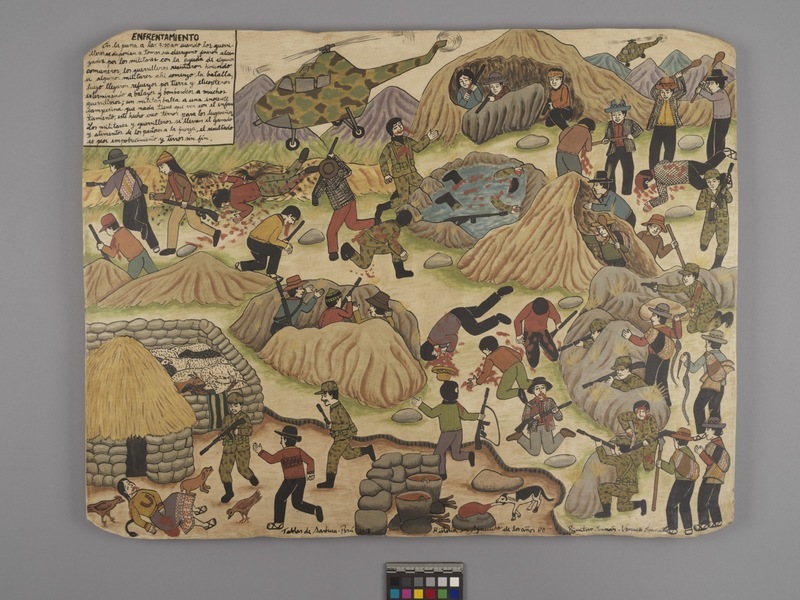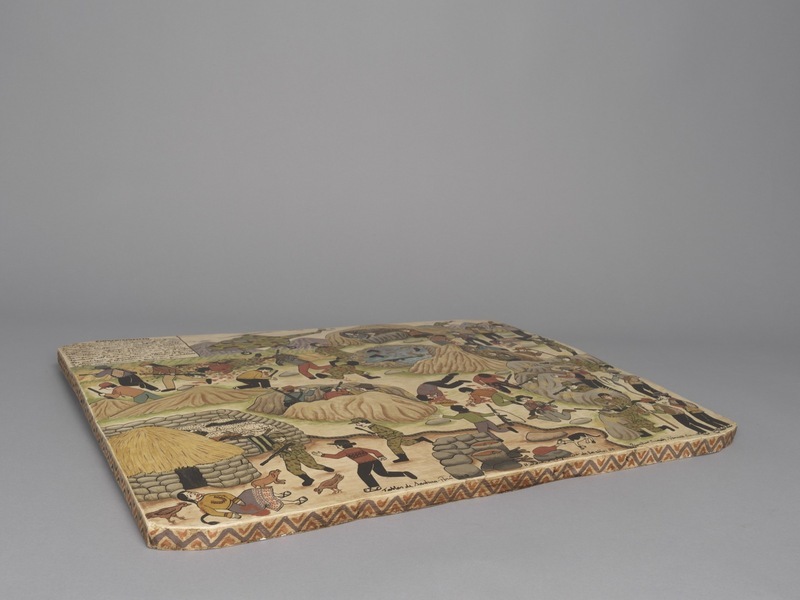Enfrentamiento Item Number: 3289/62 from the MOA: University of British Columbia


Description
Wooden panel covered in plaster or gesso and painted. The tabla shows the Peruvian State forces confronting ‘Shining Path’ guerrilla insurgents in the high plains of Ayacucho. The image shows men in Sinchi uniform as well as people in local traditional dress. A low flying helicopter painted with state camouflage is firing on everyone. The image is of destruction and bloody death. However, it also contains images of the local landscape that show continuity in painting style from the house beams (3289/60-61); a dog steals a piece of meat from the fire, chickens roam the hillside. This is the culmination of the armed conflict and shows the confusion involved in the identities of attackers and victims.
Narrative
Enfrentamiento (Confrontation), from the series ‘Piraq Causa’ (Quechua; Who is to Blame?). Number 5 in the series. A new painting format, executed on rectangular boards, was used to document the “times of danger” that resulted in the death of many Indigenous inhabitants of Ayacucho in the 1980s. The tradition of testimonial painting in Sarhua was radically transformed during the armed conflicts involving the Maoist ‘Shining Path’ movement and the State military. The Piraq Causa series denounces the human rights abuses committed by both guerrilla members and the state military. In some cases, these pictorial documents strategically exclude certain elements of the narrative, such as the hammer and sickle (showing people’s initial sympathy for the communist revolutionaries). Absences have emotional nuance in that they give expression to traumatic gaps in Sarhuino history. According to Primitivo and his family, by the time the conflict had escalated, it was unclear who the attackers were (Sinchis dressed as Maoists and the other way round), all vying for allegiance and information. Following these ‘times of danger,’ many Sarhuinos left rural Ayacucho, in many cases for Lima. As a result much of the tradition and knowledge behind this painting tradition is being lost.
Cultural Context
Reproduction of an original tabla (painting) by the maker's father, Primitivo Evanán Poma.
Item History
- Made by Venuca Evanan (Maker) in Sarhua, Ayacucho, Peru during 2018
- Collected by Laura Osorio between 2017 and 2018
- Owned by Laura Osorio before April 11, 2018
- Received from Laura Osorio (Seller), Museum of Anthropology Exhibitions Budget (Funding source) and Michael O'Brian Family Foundation (Funding source) on April 11, 2018
What
- Name
- Enfrentamiento
- Identification Number
- 3289/62
- Type of Item
- painting
- Overall
- height 53.2 cm, width 67.8 cm, depth 3.4 cm
Who
- Culture
- Peruvian
- Creator
- Venuca Evanan (Maker)
- Field Collector
- Laura Osorio
- Previous Owner
- Laura Osorio
- Received from
- Laura Osorio (Seller), Museum of Anthropology Exhibitions Budget (Funding source) and Michael O'Brian Family Foundation (Funding source)
Where
- Holding Institution
- MOA: University of British Columbia
- Made in
- Sarhua, Ayacucho, Peru
When
- Creation Date
- during 2018
- Collection Date
- between 2017 and 2018
- Ownership Date
- before April 11, 2018
- Acquisition Date
- on April 11, 2018
Other
- Item Classes
- paintings
- Condition
- good
- Accession Number
- 3289/0062